Q&A With the Pilot, Volume 6

AN OLD-TIMEY QUESTIONS AND ANSWERS SESSION.
Eons ago, in 2002, a column called Ask the Pilot, hosted by yours truly, started running in the online magazine Salon, in which I fielded reader-submitted questions about air travel. It’s a good idea, I think, to touch back now and then on the format that got this venerable enterprise started. It’s Ask the Pilot classic, if you will.
Q: I appreciated your rant about excessive public address announcements at airports and during flight. However, announcements from the cockpit can’t escape attention. Seriously, can some of your fellow pilots please stay quiet? We get what we need from the cabin crew; we don’t need the pilots piling on.
I’m okay with pilot PAs so long as they are professional-sounding, informational, jargon-free and brief.
I make one prior to departure. I say our names, then I give the flight time (I always round the minutes to zero or five), the approximate arrival time, and maybe a short description of the arrival weather. The whole thing takes fifteen seconds.
The names part is just to remind people that actual human beings are driving their plane. There’s such a disconnect between the cabin and cockpit; most passengers never even lay eyes on the individuals taking them across the country or across the ocean.
I do not start in with, “It’s a great day for flyin,’ and we’ve got eight of our best flight attendants back there for your safety and comfort,” blah blah blah. That style of folky-hokey chatter is embarrassing.
Q: When I fly, I always love the ka-thunk sound of landing gear coming down, as it signals we’re almost to our destination. Sometimes I notice it comes down much closer to touchdown than other times. Why?
Planes normally drop their landing gear at around 2,000 feet above the ground, or when passing what we call the “final approach fix.” That’s maybe three minutes from touchdown, give or take. But it varies, depending on airspeed, spacing with other traffic, and so on. Lowering the gear has a significant aerodynamic impact, mainly in the adding of wind resistance (that is, drag). Sometimes we drop it early to help slow down.
I remember going into JFK early one morning. The controllers initially kept us high and fast, then suddenly gave us a “slam dunk” clearance straight to the runway. We put the gear out at like 5,000 feet to slow down and increase our descent to the maximum possible rate. No pilot likes doing this, as it’s noisy and maybe a little disconcerting for passengers. But under the circumstances, it worked great.
At most carriers the policy is to have the gear down and the plane fully configured for landing no later than a thousand feet above the ground. The idea is to minimize power and pitch adjustments and maintain what pilots call a “stabilized approach.”
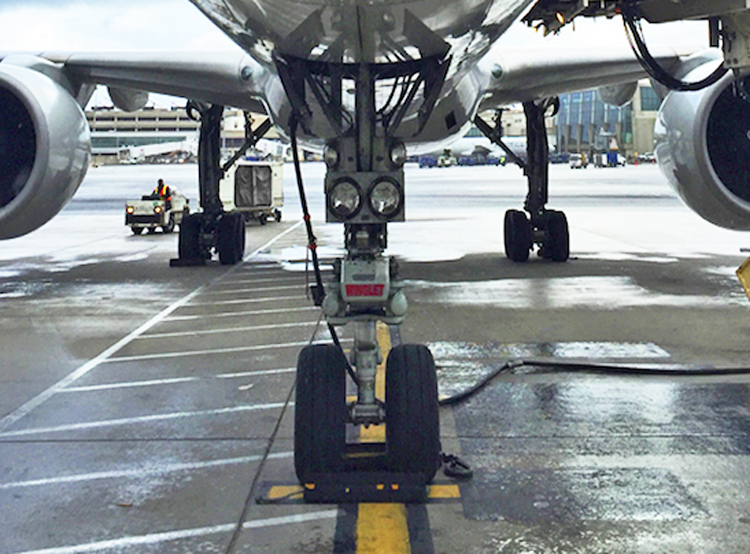
Q: And please cure this stupid irrational fear once and for all: could pilots ever forget to deploy the landing gear? What are the safeguards to ensure this doesn’t happen?
Verifying that the gear is down and locked is one of the checklist items prior to landing. There are also configuration warnings that will sound if the plane passes a certain altitude without the gear (or wing flaps) in the correct position.
On top of all that, if you still somehow managed to forget, the whole picture would look and feel wrong. The plane’s attitude would be off, the power settings would be strange, the sounds would be different.
Pilots of small private planes are known to land with their gear up from time to time, but I can’t imagine this happening in a commercial jet.
Q: I recently flew on a 737-900, in row 13. I was surprised to find that there was no window in this row, although there was ample space for one. Why?
You see this on a lot of planes. Usually it’s because there’s some sort of internal component — ducting, framing, or some other structural assembly — that doesn’t allow space for a window. Some turboprops are missing a window directly adjacent to the propeller blades, and you’ll find a strip of reinforced plating there instead. This is to prevent damage if, during icing conditions, the blades shed chunks of ice.
Q: I often listen in to air traffic control on the internet. On the approach control frequencies, pilots will call in and identify themselves “with” a character from the phonetic alphabet. For example, “Approach this is United 515 at ten thousand with Alpha or “Approach United 827, five thousand feet with Uniform.” What does this mean?
Every airport puts out a broadcast that gives the current weather, approaches and runways in use, and assorted other info particular to the airport at that moment (some of it, to be honest, unnecessary). This broadcast, called ATIS (automatic terminal information service), is identified phonetically between A and Z.
On initial contact with approach control (or with ground or clearance control when departing), pilots are asked to report in with the most current letter, verifying they’ve listened to the broadcast and have an idea of what’s going on. Each time something is updated, the broadcast advances to the next letter. I will call in “with Sierra,” and the annoyed controller will snap back, “Information Tango is now up.”
I use the words “broadcast,” and “listened to,” because traditionally crews would tune to a radio frequency for ATIS, and transcribe its highlights onto a slip of paper. Nowadays, at most larger airports, it’s delivered through a cockpit datalink printout or is pulled up on our iPads.
For no useful reason, much of the typical ATIS report is abbreviated and coded using all kinds of nonstandard shorthand, and takes some deciphering. Aviation is frustratingly averse to the use of actual words, preferring instead a soup of acronyms and gibberish. I mean, it’s not the 1950s anymore and we aren’t using teletype machines to communicate.
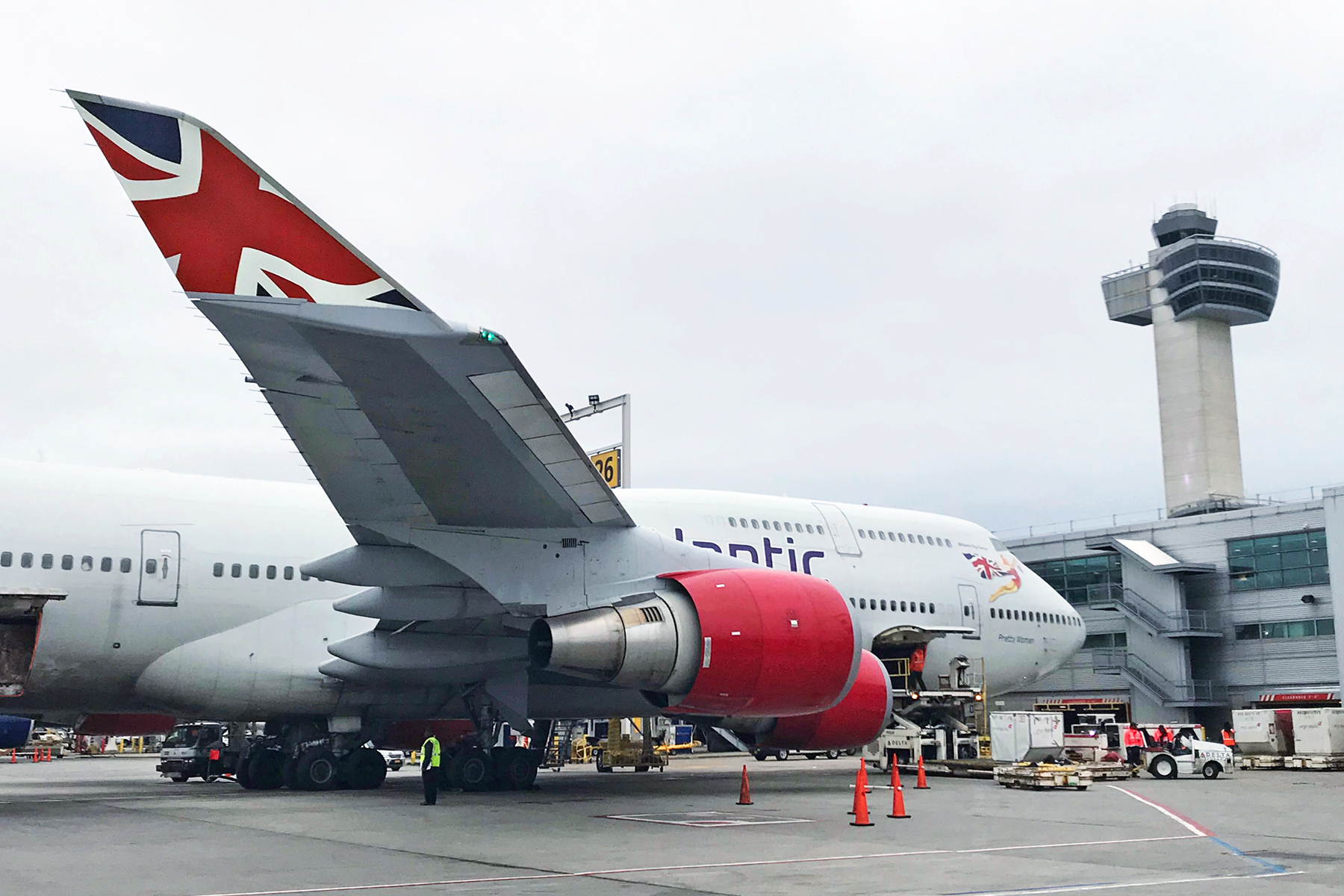
Q: Tell us something weird?
What’s weird is that I haven’t been to a rock concert in thirteen years.
That’s super weird, really, considering how deeply into music I once was, and how many hundreds of concerts I attended. I can’t explain why, exactly, but I developed a later-in-life disdain for live performances. They suddenly felt goofy and weird to me: Am I watching or listening? Where do I stand? And none of the songs sound right.
You’ll tell me I’m just getting old Whatever the reason, I stopped going, even when the musicians are ones I love.
My last time at a show was in 2010, when I went to see Grant Hart in Cambridge. Prior to that we go all the way back to 2004, when I saw the Mountain Goats, also in Cambridge. Both times I was on the guest list, which made the idea of a night out more appealing. I’m not sure I would’ve gone otherwise. (Somewhere in there was Curtis Eller the banjo guy, and some symphonies, but those don’t count.)
That said, I’m told by a reader that the Bob Mould show in New Hampshire a couple of weeks ago was great, and at least half of the songs he played were classics from the Hüsker Dü canon. I wanna say that I wished I’d gone (the last time I watched Mould play live was in 1995). I was in Tanzania on vacation, so my excuse is solid, but even if I’d been home I may not have done it.
Concerts are one thing, but worst of the worst is any kind of live music in a bar or restaurant. There’s almost nothing I hate more. At least at a concert you’re there because, presumably, you enjoy the music of the artist you’re seeing. The music in a bar may or may not be anything you like. It’s intrusive, and conversation becomes difficult.
Here I’ll make this airline-related: On layovers in Accra, Ghana, I used to love hanging out at the poolside bar at the Novotel. It was such a chill place, with the most relaxing vibe. Then they brought in a piano player. Now the racket made talking almost impossible. He’d sing, too, and the beer mugs would crack when he hit the high notes. I had to find a new place.
EMAIL YOUR QUESTIONS TO patricksmith@askthepilot.com
Related Stories:
Q&A WITH THE PILOT, Volume 1
Q&A WITH THE PILOT, Volume 2
Q&A WITH THE PILOT, Volume 3
Q&A WITH THE PILOT, Volume 4
Q&A WITH THE PILOT, Volume 5
Q&A WITH THE PILOT, Volume 6
Q&A WITH THE PILOT, COVID EDITION
Portions of this post appeared previously in the magazine Salon.

PHOTOS BY THE AUTHOR
Q&A With the Pilot, Volume 5

AN OLD-TIMEY QUESTIONS AND ANSWERS SESSION.
Eons ago, in 2002, a column called Ask the Pilot, hosted by yours truly, started running in the online magazine Salon, in which I fielded reader-submitted questions about air travel. It’s a good idea, I think, to touch back now and then on the format that got this venerable enterprise started. It’s Ask the Pilot classic, if you will.
Q: Flying out of Pittsburgh the other day, about ten minutes after taking off, the pilots deployed the landing gear for about ten seconds, then retracted it again. Nothing was said over the PA. Why would they have done this?
The pilots may have had an indication of hot or overheated brakes. Brakes can heat up during taxi, and stay hot after takeoff. The checklist might call for momentary deployment of the landing gear to help them air-cool. Or, it might have been a landing gear door not in its proper position. Again, the checklist might call for “cycling” of the landing gear.
Neither of these things is especially urgent, which would explain why they waited until 15,000 feet. The first few minutes after takeoff are quite busy.
What’s not explained is why the crew didn’t say anything. I suspect a majority of passengers would realize that dropping and retracting the gear at 15,000 isn’t normal. A quick PA was due.
Q: Prior to landing, the pilots told us they’d be lowering the landing gear much earlier than usual in order to help burn off excess fuel. I had never experienced this before
This happens rarely, but it does happen. It sounds as though your plane may have been above its maximum landing weight for the runway in use. Perhaps the flying time turned out to be significantly shorter than planned. Or, maybe, due to weather or some such, the only available runway was a shorter one than expected. Your weight determines your landing speed, which in turn affects how much distance you need. The increase in drag from dropping the gear early would significantly increase fuel burn. It’s extremely wasteful, but it works.
Larger jets have fuel jettison capabilities, but that’s more for emergency returns, medical or mechanical diverts — that sort of thing. And some planes have exemptions that permit overweight landings up to a certain point, usually requiring a post-flight inspection.
Q: When we landed in Chicago, the pilots told us we were headed into the “penalty box” because there was no available gate. We pulled over, parked, and waited over an hour. What is this penalty box?
That’s just a playful term to describe some spot on the tarmac where, for whatever reason (ATC delay, occupied gate) you’re asked to sit. An airport might have a designated area used for the purpose. Or, more often than not, it’s just an improvised location. The other night at JFK we waited about 45 minutes for a gate to open; the ground controllers sequestered us on a quiet taxiway between two runways.
Q: Okay, we’re sitting in the penalty box and the crew says our gate isn’t available. Yet I clearly see one or more wide-open gates at the terminal. Why can’t we use one?
Yes, I know, this happens all the time. Occasionally you’ll be swapped into one of those open spots, but if not, it’s normally because other inbound flights have dibs on them. Once you start swapping parking spots around at the last minute, you put a lot of different parts in motion (baggage and cargo loading and unloading, and so on), which leads to screw-ups further along. And what time a flight is do out has a lot to do with which gate it needs to use on the way in. It’s a matrix. I’ve had conversations with the apron staff about this, and came away realizing it’s not as simple as it seems.
Keep in mind, too, that the gates you see out the window might belong to another carrier. In the U.S. most gate space is proprietary. American doesn’t use United’s gates, or vice-versa. Their facilities, and the personnel that run those facilities, are separate — unlike in other parts of the world, where gates and concourses often are shared.
Q: I was watching the ramp crew give hand signals to the pilots as a jet was pulling in to the gate. Some of the gestures were obvious, like the guy at the nose moving his batons closer together until they crossed, telling the plane to stop. But why did the same guy raise his arms and flash four finger, two or three times in rapid succession? What did that mean?
He was telling the pilots that the plane’s landing or taxi light was still on, and was perhaps shining in his face. The taxi lights are usually located on the nose gear strut, and we switch them off once we turn into the parking bay to avoid blinding the marshaler. Occasionally if there’s a lot activity or we’re busy looking outside, we forget.
EMAIL YOUR QUESTIONS TO patricksmith@askthepilot.com
Related Stories:
Q&A WITH THE PILOT, Volume 1
Q&A WITH THE PILOT, Volume 2
Q&A WITH THE PILOT, Volume 3
Q&A WITH THE PILOT, Volume 4
Q&A WITH THE PILOT, Volume 5
Q&A WITH THE PILOT, Volume 6
Q&A WITH THE PILOT, COVID EDITION
Portions of this post appeared previously in the magazine Salon.

Q&A With the Pilot, Volume 3

AN OLD-TIMEY QUESTIONS AND ANSWERS SESSION.
Eons ago, in 2002, a column called Ask the Pilot, hosted by yours truly, started running in the online magazine Salon, in which I fielded reader-submitted questions about air travel. It’s a good idea, I think, to touch back now and then on the format that got this venerable enterprise started. It’s Ask the Pilot classic, if you will.
Expect more of these Q&As in the coming months, if for no other reason than I enjoy putting them together. They’re geeky, but they’re fun. And I’ll never run out of fodder. It’s the nature of the business, I suppose: commercial flying is vastly misunderstood, and one of those things that everybody has a question about.
That’s good for business, but it’s frustrating as well, because much of what the public presumes about commercial flying is based on bad information. If there’s a Golden Rule to this gig, it’s this: never, ever, underestimate the traveling public’s disdain for the airlines and its willingness to believe almost every false rumor, exaggerated story and conspiracy theory. I receive many emails beginning with the words “Is it true that…” and inevitably it’s my duty to politely informing the reader that the answer is no.
Q: Is it true that jetliners have windshield wipers?
No.
I mean, yes. This might strike you as quaint, but most airliners are indeed equipped with wipers. They’re used on the ground, and during takeoff takeoffs and landings if precipitation is heavy. They are effective at keeping the windscreen clear, but tend to be very noisy. Often there’s a speed restrictions (around 200 knots, give or take), above which they should not be turned on. Some planes use a system that instead blows engine bleed air across the glass. Cockpit windows are also electrically heated to prevent ice and frost accretion. The individual panels use separate circuits and heating elements so that a failure will affect only one section. Heating also increases flexibility, providing extra protection against bird strikes.
The glass is unbelievably strong — bank-teller thick and bolstered by high-strength frames. Somewhere on YouTube is a video of maintenance workers attempting — and failing — to shatter a discarded cockpit windscreen with a sledgehammer.
If that all sounds expensive, it is. Swapping out a single cockpit pane can run tens of thousands of dollars.
Q: I was on a flight to Madrid, and about halfway through the captain said we needed to make an emergency landing because of a crack in the cockpit windshield. A short while later he told us that because we’d descended to a suitable altitude, we could proceed to Madrid as planned. I would think that with a crack in the windshield you’d want the plane on the ground ASAP.
Strong as they are, aircraft windscreens occasionally do crack. In all but the rarest cases, however, cracking will not cause a shattering or rupture of the window. How to deal with the crack depends on its size, the location, and how many layers of the glass are affected (there are multiple layers). The checklist might call for a speed reduction, and/or depressurizing in order to reduce stress on the glass. Or it might call for nothing at all.
Depressurizing requires a descent to no higher than 10,000 feet. Once at the appropriate height and speed, and so long as fuel allows, it may be possible to continue flying without further trouble.
This is the kind of thing that the crew would coordinate with maintenance personnel. Ultimately it’s the captain’s decision, but dealing with malfunctions is often a team effort between the pilots and staff on the ground, with whom we communicate via datalink or radio.
Q: We were sitting at the gate, preparing to board a flight to San Francisco. The plane was a 757. I was amazed when I looked out and suddenly saw one of the pilots with his arm hanging out the cockpit window!
Another peculiarity of cockpit windows is that some of them can be opened when the plane is on the ground. It’s normally the side windows — never those in the front — that have this capability, and only on some aircraft. The 757s and 767s that I fly are two of those aircraft. It gets hot in the cockpit with all of the lights on and electrical equipment humming, and I often crank a window open for fresh air.
The apparatus that does the latching and sliding is strictly mechanical, and also allows the window to be used as an emergency exit. It’s a long way down, so an escape rope is usually tucked into an adjacent sidewall or ceiling panel. (When commandos stormed a hijacked Air France flight in Algeria in 1995, the first officer fractured an elbow and thigh after leaping 16 feet from the cockpit of an Airbus A300.) The window fits into the frame much like a plug, and similar to how an aircraft’s doors cannot be opened during flight, neither can its windows, so long as the plane remains pressurized.
While all that glass makes for a splendid view and the chance for some fresh air, it also has a downside. Namely, noise. Going nose first into 600 miles-an-hour of onrushing air produces an exceptional racket. Ambient cockpit noise levels average about 75 decibels. Over the course of a multi-hour flight, that induces fatigue. Over the course of a career, it induces hearing loss. Engineers have tinkered with active noise reduction technology and better insulation, but the easiest way of dealing with the problem is either with a noise reducing headset or, more routinely, a pair of foam earplugs.
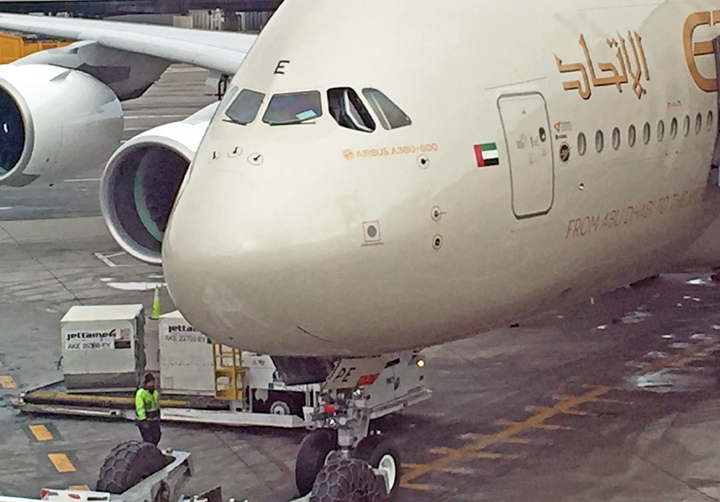
An A380 with open cockpit window. Photo by the author.
Q: It has always puzzled me why airliners deploy their landing gear so long before landing, yet tuck it away almost immediately after lifting off. Dropping the wheels so soon must cause a lot of extra drag and fuel burn.Sometimes that drag is helpful. Dropping the gear can be a useful tool when air traffic control sets you up too high or needs you down in a hurry. This causes a racket, however, and isn’t the most graceful way of descending or decelerating.
Normally we deploy the landing gear at somewhere around 2,000 feet on final approach. Mainly it’s just to be certain that everything is steady and stable at a reasonably early point. Lowering the gear has a significant aerodynamic impact — mainly in the adding of wind resistance, i.e. drag — thus requiring power and pitch adjustments to maintain speed, altitude, or rate of descent. It’s best to have that out of the way early on to help establish what pilots call a “stabilized approach.” Deploying the gear close-in to the runway could cause a sudden shift in airspeed and attitude exactly when it’s critical not to have a sudden shift in airspeed and attitude.
On takeoff, however, this works to a plane’s advantage. Remember, the moments just after liftoff are the most critical moments of any flight. The plane is making the transition from ground to air, and margins are relatively thin. The more help it can get — such as eliminating the drag caused by dangling struts, tires and doors — the better. On approach, by contrast, flight is well established and the margins much fatter.
All planes have maximum speeds for deployment and retraction. Airstream stress is more of an issue for the doors than for the gear assembly itself. For this reason, some of the doors will open as the gear comes down, then close up again.
Q: Whenever I have a window seat, I watch for the deployment of the wing flaps, especially during takeoffs. There have been crashes because pilots “forgot” to extend the flaps. Can you explain the process involved with the flaps?
Flaps help a wing generate lift at low speeds. Commercial aircraft will take off with the flaps extended to some intermediate position. The specific position, calculated prior to departure, depends on weight and runway length. On planes that are so equipped, leading-edge slats will also be deployed. These droop down from the forward part of the wing, and provide the same function as flaps. Flaps and slats work in concert, and are extended or retracted using the same control lever. In other words, moving the lever to a certain position will adjust both surfaces.
(On the 767 that I fly, setting the flap lever to position 1 drops the slats to the so-called midrange position while the flaps remain up. Moving the lever further, to the 5 position, which is the one most commonly used for takeoff, the slats remain in the midrange setting but the flaps extend slightly. On landing, setting the flaps to positions 15 through 30 moves the slats all the way down, while the flaps extend even further.)
Flap position is verified, re-verified, and verified again prior to takeoff. At my carrier, our checklists include no fewer than three challenge-and-response calls before reaching the runway. On top of that, commercial planes are equipped with a warning sensor that sounds an alarm if the flaps are not deployed at the moment thrust is advanced for takeoff. When using the checklists, we verify not only the flap handle position, but the indicator gauge also, to make sure the flaps’ actual position agrees with the commanded position. If or some strange reason they don’t agree, and for some strange reason we missed this, a separate warning system is triggered.
So, how it is that planes have crashed on takeoff because flaps weren’t properly set? I can think of three cases when this did indeed happened. In all three it was due to a combination of unusual circumstances: The pilots were rushed and neglected to verify position, and, for reasons that investigators could not decipher, there was a simultaneous failure of the warning system. Nowadays, however, improved checklist discipline makes a repeat of this type of accident extraordinarily unlikely.
Flaps and slats are very important during landing as well, but there’s more wiggle room here. Should they fail to deploy, either partially or at all, we can adjust by using a faster approach speed. This, in turn, affects landing distance, braking, and so on, sometimes to the point where a plane will need to divert to a longer runway. “No-flap landings” are a common simulator exercise.
EMAIL YOUR QUESTIONS TO patricksmith@askthepilot.com
Related Stories:
Q&A WITH THE PILOT, Volume 1
Q&A WITH THE PILOT, Volume 2
Q&A WITH THE PILOT, Volume 3
Q&A WITH THE PILOT, Volume 4
Q&A WITH THE PILOT, Volume 5
Q&A WITH THE PILOT, Volume 6
Q&A WITH THE PILOT, COVID EDITION
Portions of this post appeared previously in the magazine Salon.

Q&A With the Pilot, Volume 4

AN OLD-TIMEY QUESTIONS AND ANSWERS SESSION.
Eons ago, in 2002, a column called Ask the Pilot, hosted by yours truly, started running in the online magazine Salon, in which I fielded reader-submitted questions about air travel. It’s a good idea, I think, to touch back now and then on the format that got this venerable enterprise started. It’s Ask the Pilot classic, if you will.
Q: Why is engine power cut back shortly after taking off? Takeoff is the scariest part of flying to me, and suddenly, only seconds after leaving the ground, it feels like the plane is falling.
Planes routinely use more thrust than is necessary to take off, and the output of the engines is routinely drawn back to what we call “climb thrust” or “climb power” after reaching a thousand feet or so. This saves wear and tear on the engines, reduces noise on the ground, and keeps the jet from overspeeding (there are speed limits, yes, varying with altitude or the departure procedure). The sounds and sensations of this cutback are sometimes quite noticeable, but trust me the plane is not descending, or even decelerating. It’s simply not climbing as sharply, and the rate of acceleration is reduced.
Q: Sometimes while a plane is accelerating for takeoff, there’s a repetitive, rhythmic thumping from below: bang-bang-bang-bang, all the way down the runway like we’re hitting a string of potholes. A friend tells me this is an indication of flat spots on a plane’s tire, or a tire that isn’t inflated properly.
Another good reason to ignore your friends. What you’re hearing is the plane’s forward landing gear — its nose tires — hitting the recessed lights along the runway centerline. These centerline lights are inlaid flush with the pavement, but they’re not that flush and almost always you can feel them. One technique is to track a few feet off-center. The takeoff roll is seldom perfectly straight, however — especially during strong crosswinds — and so the bumps might start and stop, start and stop.
Q: I understand that a plane’s control wheel or side-stick is used for turns during flight, but what about on the ground? Is this same method used to guide a plane along taxiways, like the steering wheel in a car?
The main control wheel or side-stick links only to the ailerons and has no function on the ground. Instead, steering is controlled mainly through use of a tiller — a steering wheel-like device that is side-mounted near the pilot’s knee and connected to the forward (nose) landing gear. On some planes only the captain’s side has a tiller; other planes have them on both sides. The rudder pedals also have limited control over the nose gear. Pedal steering is used during takeoff, and after landing until the plane has reached a safe taxi speed. The plane I fly has a tiller only on the captain’s side. After one of my extremely smooth landings I can easily maneuver the jet clear of the runway using the pedals. The captain then takes over with the tiller.
Q: On the ground, can a plane move backwards under its own power?
A plane’s wheels are equipped with highly sophisticated brakes and anti-skid technology, but they are not geared or directly driven like the wheels of an automobile — such hardware would be heavy, complicated, expensive, and then only of marginal use. The tires roll free; the plane moves only in the direction that engine thrust tells it to move. Thus, give it enough reverse thrust, and sure, a plane can be made to roll backwards. For reasons of both cost and safety, however, this is almost never done. Instead, a tug is used.
American Airlines was among a few carriers that once authorized so-called “powerbacks” for its MD-80 series planes. The MD-80 was a good choice for this, as its engines are aft-mounted and high off the ground, keeping jet blast clear of people and equipment. Still, while it saved a little time and reduced wear and tear on the nose-gear struts, it wasn’t worth the ruckus and added fuel costs. Also, directional control is difficult and braking has to be managed carefully. Rolling backwards, a tail-heavy plane is liable to tip on its rear end if the brakes are applied forcefully enough.

There’s usually a small team of dudes or dudettes that pushes the plane from the gate. One of these people is connected to the cockpit via a headset. The apron or ground controllers will sometimes give complicated pushback instructions — and/or they will change them in the middle of the push — so the pilots needs to let the ground team know where, exactly, to maneuver the plane. The ground team lets the pilots know when its safe to start the engines, and then verifies that the tug has been safely disconnected from the landing gear.
Q: I was reading about a 747 that lost all four engines after flying through volcanic ash over the Pacific several years ago. That got me thinking. If a 747 or other large plane is forced to glide, how far can it travel, and how much control would the pilots have?
Well, from 30,000 feet you could figure on a hundred miles worth of glide, give or take. Failure of all engines is, to be clear, a full-blown emergency, yet there’s no more a prospect of instant calamity than taking your foot off the accelerator when coasting downhill in a car. The car keeps going and a plane will too. In fact the power-off performance of a large jet is better than that of a light Piper or Cessna. It needs to glide at a considerably higher speed, but the ratio of distance covered to altitude lost — close to a 20:1 ratio — is almost double.
While it may surprise you, it’s perfectly routine for jets to descend at what a pilot would call idle thrust, i.e. with the engines run back to a zero-power condition. They’re still operating powering the various systems, but providing very little push — not a lot different from switching them off entirely. You’ve been gliding on almost every flight without knowing it.
As for control capability, that depends on the aircraft type. An airplane’s internal systems are powered hydraulically, electrically, or pneumatically, and they react differently to power failures. Multiple engine loss will render many components inoperative, but no aircraft will tumble from the sky. They all can glide. On some aircraft, multiple engine failure causes a small wind turbine to utomatically deploy into the slipstream to help provide control authority.
Total engine loss is about as probable as a flight attendant volunteering to give you a shoe-shine, though it has happened:
Southern Airways flight 242 (1977). Hail and water ingestion. Fatalities: 72
United flight 173 (1978). Fuel exhaustion/negligent fuel management. Fatalities: 10
British Airways flight 009 (1982). Volcanic ash. Fatalities: 0
Air Canada flight 143 (1983). Human error and fuel exhaustion. Fatalities: 0
TACA Flight 110 (1988). Severe rain ingestion. Fatalities: 0
KLM flight 867 (1989). Volcanic ash. Fatalities: 0
Varig flight 254 (1989). Crew error and fuel exhaustion. Fatalities: 13
SAS flight 751 (1991). Severe ice ingestion. Fatalities: 0
Ethiopian Airlines flight 961 (1996). Hijacking and fuel exhaustion. Fatalities: 125
Hapag-Lloyd Flight 3378 (2000). Crew error, mechanical problem, fuel exhaustion. Fatalities: 0
Air Transat flight 236 (2001). Mechanical problem and fuel exhaustion. Fatalities: 0
British Airways flight 38 (2008). Fuel system problem. Fatalities: 0
US Airways flight 1549 (2009). Bird strike. Fatalities: 0
LaMia flight 2933 (2016). Fuel exhaustion/negligent fuel management. Fatalities: 71
That might seem like a pretty long list, but in the grand scheme of things such events are exceptionally rare. And notice all those zeroes. (The Ethiopian incident in 1996 would have had a much better outcome had the hijackers and pilots not been wresting for control at the time of impact.)
The British Airways incident in 1982 occurred after an encounter with an unforecast ash cloud from Indonesia’s Mount Galunggung. The crew managed to re-start three of the engines, then pulled off a nighttime, non-precision localizer approach into Jakarta even though the ash had scraped up the windscreen to the point where visibility was almost nil. Captain Eric Moody, in one of aviation’s all-time greatest quotes, described the landing as, “a bit like negotiating one’s way up a badger’s arse.”
Q: What do you think of this great idea: The plane should have a video camera aimed through the cockpit windshield, with the view wired into the seatback video screens letting passengers see what the pilot sees.
What I think is this already exists. Many airlines — alas, most of them outside the United States — display one or more camera views on the seatback screens. Often there are multiple angles, and passengers can click between them. There are cameras showing what the pilots see, others that point straight down. Sometimes there’s one aimed backwards, off the tail, providing an unusual, some would say harrowing view of the ground falling away during takeoff. It depends on the aircraft and airline. You’ll typically find this on the A330, A340, A380 and 777.
For a while in the 1970s, American Airlines had a camera mounted on the aft cockpit wall of its DC-10s. The view was projected onto the bulkhead movie screen and passengers could watch the pilots doing their thing during takeoffs and landings. The footage could be grainy and washed out, but it was, for its time, quite a novelty.
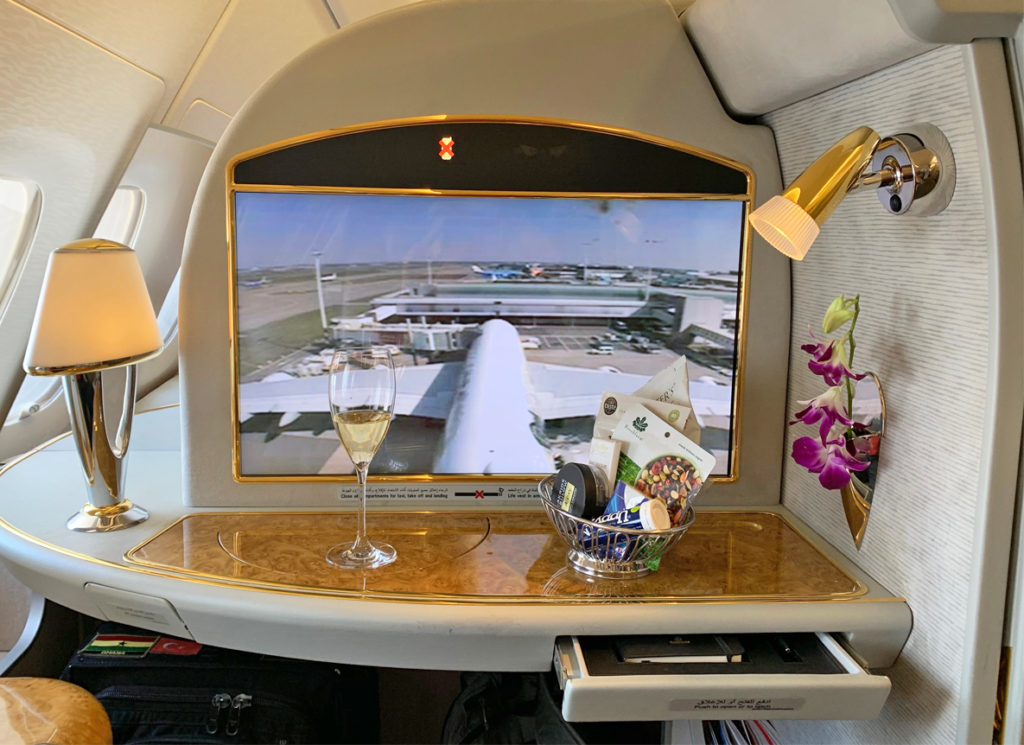
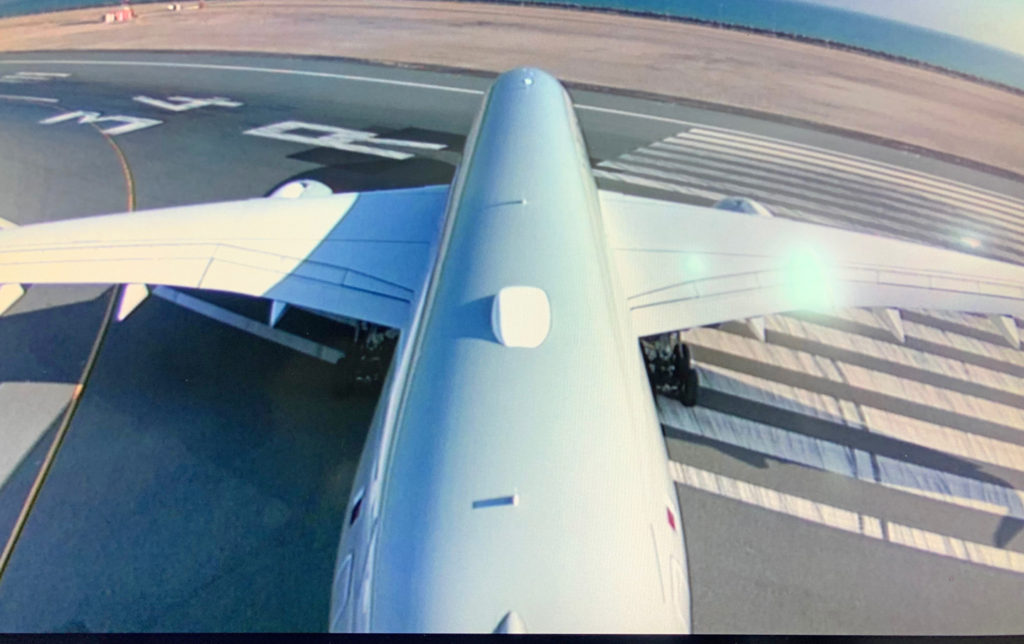
Q: Why can’t video cameras be embedded at various places on the exterior of the aircraft as a means for the pilots to evaluate the condition of the aircraft?
There are a lot of little things in aviation that could, or should, be standard, but aren’t for reasons that almost nobody can fathom. Things in aviation progress glacially, and are generally about ten generations behind whatever the rest of technology (and common sense) is doing.
But, to be fair, it’s also because merely seeing something doesn’t necessarily tell you how or if it’s working properly. Because a set of landing gear is visibly extended does not mean that it’s locked in place or otherwise is fully operational. In a lot of ways, the gauges and status screens in the cockpit are more valuable than what some poor-quality video might show. All of that said, some newer planes do have exterior cameras to assess the condition of landing gear, wingtip clearance and whatnot.
ALL PHOTOS BY THE AUTHOR
EMAIL YOUR QUESTIONS TO patricksmith@askthepilot.com
Related Stories:
Q&A WITH THE PILOT, Volume 1
Q&A WITH THE PILOT, Volume 2
Q&A WITH THE PILOT, Volume 3
Q&A WITH THE PILOT, Volume 4
Q&A WITH THE PILOT, Volume 5
Q&A WITH THE PILOT, Volume 6
Q&A WITH THE PILOT, COVID EDITION
Portions of this post appeared previously in the magazine Salon.

PHOTOS BY THE AUTHOR
Q&A With the Pilot, Volume 2

AN OLD-TIMEY QUESTIONS AND ANSWERS SESSION.
Eons ago, in 2002, a column called Ask the Pilot, hosted by yours truly, started running in the online magazine Salon, in which I fielded reader-submitted questions about air travel. It’s a good idea, I think, to touch back now and then on the format that got this venerable enterprise started. It’s Ask the Pilot classic, if you will.
Q: On a flight from London to New York, I noticed that our 747 was flying almost parallel with, and very close to, a Lufthansa plane. It remained next to us for at least a couple of hours as we crossed the Atlantic. We were close enough that I could clearly see the tail emblem and the Lufthansa name on the fuselage. I assume our pilots were aware of it, and vice versa?
What you describe is common when flying between Europe and North America. The east-west routes across the North Atlantic consist of a series of one-way parallel “tracks,” as we call them, made up of sequential points of latitude and longitude. Flights along the same track are sequenced by time, one behind the other. Or, they are stacked vertically, with a minimum of 1,000 feet between each plane. The tracks are 60 miles apart, however, so you were likely on the same track as the Lufthansa jet, a thousand feet higher or lower, and slightly offset horizontally.
Offsetting horizontally reduces collision hazards, unlikely as they are, and helps avoid wake turbulence. Standard offsets are 1 mile or 2 miles (pilot’s choice) to the right. A plane one or two miles away horizontally and only a thousand feet lower or higher will basically appear parallel to you.
The tracks go west-to-east in the evening, when the vast majority of planes depart North America for Europe, and east-to-west in the mornings and afternoons, when most flights are headed the other way. Those going against the flow — a morning flight from New York to London, for example — will be assigned a “random route,” clear of the organized tracks. Each track is assigned a letter designation. The locations of the tracks are different every day, varying with weather and winds aloft. Track “A” on Tuesday might consist of a totally different string of latitude/longitude fixes than Wednesday’s track “A.”
Separate from ATC communications, there’s an open radio frequency (VHF 123.45) used on the track system that allows crews to talk to each other. While this is useful for passing on information about turbulence and whatnot, a lot of the conversation is casual. The likes of “What’s up? Where are you guys headed?” is heard all the time. It’s quite possible that your crew and the Lufthansa crew were chatting at some point.
Q: How come there are no direct flights from Europe to Hawaii? The distance is somewhere around 6,000 nautical miles from the bigger Western European capitals, but that’s well within the reach of long-haul aircraft.
I can’t imagine such a route would be profitable. It has two critical factors working against it. First, it’s a very long distance. Second, it’s a leisure destination with little premium-fare traffic, meaning that yields would be low. Cheap tickets, limited first or business class traffic, and long distances: that’s a terrible economies-of-scale combo that will only work if you can consistently fill a jumbo jet to the gills. And even that’s no guarantee of turning a profit. And how many Europeans are interested in vacationing in Hawaii in the first place? There are many closer sun-and-sea options: Turkey and the Mediterranean, the Indian Ocean resort islands, Thailand, etc. Heck, there wasn’t even a Hawaii to New York nonstop until just a couple of years ago when Hawaiian Airlines came in to give it a try (the route continues, though I’ve been told it only makes money in the winter high season). Most people headed to Hawaii will connect through one of the bigger West Coast cities.
Q: I love watching airplanes in the night sky, but what do all the different lights mean? You’ve got green lights, red lights, white lights; steady lights and flashing lights. What does it all mean?
Wow, you’re really going to make me do this? If you insist. Mind you there are variations, but here’s a generic rundown:
Navigation lights (wingtips and tail): Colored lights that show a plane’s orientation: red on the left, green on the right, white in the back. Always turned on.
Anti-collision lights (on the wingtips and sometimes the upper or lower fuselage as well): Very bright, white flashing lights that basically mean “look out, here we are!” Used night and day. Turned on just prior to the takeoff roll; turned off again just after landing.
Rotating beacon (upper or lower fuselage): A red flashing light used any time aircraft is moving. Turned on just prior to taxiing or towing; turned off again after engine shut-down. Means, “stay clear!”
Landing lights (most commonly wing-mounted and/or mounted on the nose gear strut): Very bright, white, forward facing beams. Used during takeoff, approach and landing. Always off for taxi and cruise flight.
Taxi lights (normally on nose gear strut): White, forward facing beams. Assist with ground visibility during taxi. Usually left on for takeoff and landing as well.
Runway turnoff lights (if installed, wing-mounted): Bright white lights aimed slightly askew, to aid in high-speed turns when exiting the runway.
Logo lights (if installed): Spotlights mounted in the top of the horizontal stabilizer and aimed at the tail. Shows off your carrier’s ugly logo and helps pilots and ground controllers identify traffic. On for taxi, takeoff and landing; optional during cruise.
EMAIL YOUR QUESTIONS TO patricksmith@askthepilot.com
Related Stories:
Q&A WITH THE PILOT, Volume 1
Q&A WITH THE PILOT, Volume 2
Q&A WITH THE PILOT, Volume 3
Q&A WITH THE PILOT, Volume 4
Q&A WITH THE PILOT, Volume 5
Q&A WITH THE PILOT, Volume 6
Q&A WITH THE PILOT, COVID EDITION
Portions of this post appeared previously in the magazine Salon.



